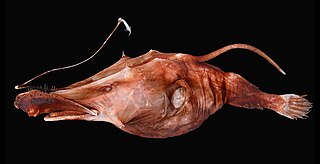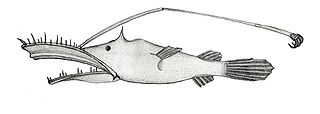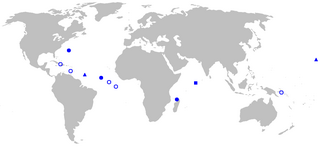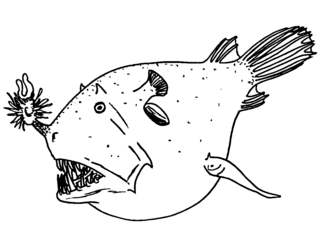
Leftvents are small, deep-sea lophiiform fish comprising the family Linophrynidae distributed throughout tropical to subtropical waters of all oceans.

The footballfish form a family, Himantolophidae, of globose, deep-sea anglerfishes found in tropical and subtropical waters of the Atlantic, Indian, and Pacific Ocean. The family contains 23 species, all of which reside in a single genus, Himantolophus.

Linophryne arborifera, or illuminated netdevil, is an anglerfish of the family Linophrynidae, found in all tropical and subtropical oceans at depths below 1,000 m (3,300 ft) in the Bathyal zone. Its length is up to 77 mm. The female is significantly larger than the mature, parasitic male.

The dreamers are a family, Oneirodidae, of deep-sea anglerfishes in the order Lophiiformes. They are the largest and most diverse group of deep-sea anglerfish, and also the least well known with 16 genera represented by only one, two, or three female specimens. There are over 60 species within the family, and that contains more females than males. They are found in deep, temperate waters around the world. They are small fish, the largest species only growing to about 20 cm (7.9 in) in total length. The largest female size that is known is about 370-mm and the largest known male is 16.5 mm. Females are dark brown to black all over their entire body, meanwhile males are also dark brown to black, but the nasal area is not pigmented for them. Female dreamers are found in a preservative dark brown to black color externally except for the escal appendages and distal portion of the escal bulb. Males are also the same color, except in their nasal areas.

Lasiognathus saccostoma is a species of wolftrap angler known from the eastern central Pacific Ocean and tropical waters of the Atlantic Ocean. It is found at depths to 4,000 metres (13,000 ft). The females of this species grow to a length of 7.7 centimetres (3.0 in) SL. This species has a slender, compressed prolongation at the tip of its elongated, cylindrical distal escal appendage, with numerous lateral serrations and distal filaments. Unlike in L. amphirhamphus, there are three escal hooks and they are darkly pigmented. The posterior escal appendage is broad and laterally compressed, and relatively larger than in L. amphirhamphus. No males or larval specimens have ever been found.
Bertella idiomorpha is a species of deep-sea anglerfish found in the northern Pacific Ocean. It is the only species in the genus Bertella, in the family Oneirodidae, and can be distinguished from other members of the family by the structure of its hyomandibular bone.
Spiniphryne gladisfenae, also known as the prickly dreamer, is a species of dreamer. Dreamers are a type of deep sea anglerfish known only from the Atlantic Ocean. Anglerfish are classified by how they lure their prey. Female anglerfish have a piece of dorsal spine that protrudes above their mouth and is luminescent in order to attract prey. The females of the species Spiniphryne gladisfenae can grow to a length of 10.5 centimetres (4.1 in) SL. The esca contains two bulbous appendages on the tip, covered with tiny papillae and with clusters of tiny filaments around the base. There is also a large appendage on the back, divided at the end into three lobes or many filaments. The number of lateral escal filaments varies from none to three. S. gladisfenae also has fewer dental teeth than S. duhameli.

Phyllorhinichthys is a genus of dreamers. Like other oneirodids, they are small, bathypelagic fish with bioluminescent lures. Phyllorhinichthys is unique amongst the deep-sea anglerfish in having a pair of fleshy, leaf-like structures on its snout.

Phyllorhinichthys balushkini is a species of dreamer found in the Atlantic Ocean. The females of this species grow to a length of 14.5 centimetres (5.7 in) SL. The illicium is longer than that of P. micractis. The esca bears a single forward appendage containing a pair of internal light-guiding tubes that diverge from each other at the tip. The rear escal appendage is extremely long, measuring over half the length of the fish, covered with dark skin and ending in a pair of translucent bulbs. The snout flaps are relatively small.

The Wonderfish (Thaumatichthys) is a genus of deep-sea anglerfish in the family Thaumatichthyidae, with three known species. Its scientific name means "wonder-fish" in Greek; oceanographer Anton Bruun described these fishes as "altogether one of the oddest creatures in the teeming variety of the fish world." In contrast to other anglerfishes, the bioluminescent lure of Thaumatichthys is located inside its cavernous mouth. They are worldwide in distribution and are ambush predators living near the ocean floor.

Lasiognathus amphirhamphus is a species of wolftrap angler found in the Madeira Abyssal Plain in the east-central Atlantic Ocean where it occurs at a depth of from 1,200 to 1,305 metres. The females of this species grow to a length of 15.7 centimetres (6.2 in) SL. This species is characterized by having only two bony hooks on its esca, which are lightly pigmented. The distal escal appendage is elongated and cylindrical with a long, compressed prolongation at the tip as in L. saccostoma. The prolongation has six tiny filaments at the tip and no lateral serrations. The posterior escal appendage is broad and laterally compressed. Its species name is from the Greek for "double hook", referring to its escal hooks.

Lasiognathus beebei is a species of wolftrap angler known from around the Hawaiian Islands in the Pacific Ocean and from around Madeira and Bermuda in the Atlantic. It is found at depths of around 1,100 metres (3,600 ft). The females of this species grow to a length of 11.5 centimetres (4.5 in) TL. This species is distinguishable by its hooks being placed on a short, transverse, fan-shaped distal escal appendage as opposed to the elongated, cylindrical appendage of all other species. Its species name honors naturalist William Beebe.
Lasiognathus intermedius is a species of wolftrap angler known from the western Atlantic Ocean and the southeastern Pacific Ocean where it occurs at depths of around 1,265 metres (4,150 ft). The females of this species grow to a length of 12.9 centimetres (5.1 in) SL. This species has an elongated, cylindrical distal appendage with a short, cylindrical prolongation at the tip without any lateral serrations or filaments. The posterior escal appendage is cylindrical in shape. Its species name refers to its esca being intermediate in shape between those of L. beebei and those of L. saccostoma and L. waltoni.
Lasiognathus waltoni is a species of wolftrap angler known from the eastern central Pacific Ocean. This species is found at depths to around 1,350 metres (4,430 ft). The females of this species grow to a length of 9.4 centimetres (3.7 in) SL. This species is characterized by a membranous anterior crest on its escal bulb, and an elongated, cylindrical distal escal appendage without a prolongation at the tip. Its species name honors Sir Isaac Walton, author of The Compleat Angler.

The anglerfish are fish of the teleost order Lophiiformes. They are bony fish named for their characteristic mode of predation, in which a modified luminescent fin ray acts as a lure for other fish. The luminescence comes from symbiotic bacteria, which are thought to be acquired from seawater, that dwell in and around the sea.

Rhynchactis is a genus of deep-sea anglerfish in the family Gigantactinidae, containing three species found worldwide at depths greater than 400 m (1,300 ft). Adult female Rhynchactis reach a standard length (SL) of 11–13 cm (4.3–5.1 in) and have a dark-colored, streamlined body and a relatively small head bearing a very long illicium. Unlike almost all other deep-sea anglerfishes, the illicium bears no bioluminescent esca at the tip. The mouth is almost devoid of teeth, and the inside of both jaws are covered by numerous white glands that are unique to this genus.

Borophryne apogon, the netdevil, or greedy seadevil, is a species of leftvent anglerfish known today from the waters of the eastern Pacific Ocean off the Central American coast. It is found at depths down to around 1,750 m (5,700 ft). This species grows to a length of 8.3 centimetres (3.3 in) TL. A fossil specimen of this species has been found in the Los Angeles Basin dating back to the Late Miocene, some eight million years ago.
Lasiognathus dinema is a species of wolftrap angler found in the deep waters of the northern Gulf of Mexico. It is found at depths of around 3,280 to 4,900 feet.

Linophryne indica, or headlight angler, is a leftvent anglerfish in the family Linophrynidae, found in the bathyal zone of the Pacific Ocean at depths below 1,000 m (3,300 ft). The female is significantly larger than the mature male. A fossil specimen of this species has been found in the Los Angeles Basin dating back to the Late Miocene, some eight million years ago.
Oneirodes carlsbergi is a species of anglerfish in the family Oneirodidae (dreamers). It takes its name from the Carlsberg Foundation, which funds scientific research.














